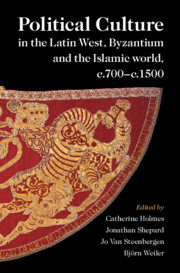 Political Culture in the Latin West, Byzantium and the Islamic World, c.700–c.1500
Political Culture in the Latin West, Byzantium and the Islamic World, c.700–c.1500 Community, Leadership and Contested Patterns of Continuity
from Part III - Norms, Values and Their Propagation
Published online by Cambridge University Press: 11 August 2021
The early caliphate adopted the political organisation predominant in the late antique Middle East – imperial monarchy, sanctioned by divine power – but with a distinctively Islamic ideology of leadership involving kinship, piety, victory and justice. The prime location for the performance of royal power was the court, particularly for caliphal accessions or successions. The warrior rulers filling the caliphal vacuum after 945 adopted Islamic means of legitimisation, including oaths of loyalty, honorific titles, robes of honour, and being named on coinage and in Friday prayers; while the ʿulamaʾ increasingly claimed spiritual authority as ‘heirs of the Prophet’. The new Turco-Mongol elites from the thirteenth century on found a role for military strongmen, incorporating the nomadic virtues of strong leadership, good fortune and royal genealogy into a fluid mixture of ideologies. Performance of power encompassed the hajj, hunting parties, public sessions dispensing justice and rituals designed to bind the palaces of the court more closely to the towns wherever they were based.
To save this book to your Kindle, first ensure [email protected] is added to your Approved Personal Document E-mail List under your Personal Document Settings on the Manage Your Content and Devices page of your Amazon account. Then enter the ‘name’ part of your Kindle email address below. Find out more about saving to your Kindle.
Note you can select to save to either the @free.kindle.com or @kindle.com variations. ‘@free.kindle.com’ emails are free but can only be saved to your device when it is connected to wi-fi. ‘@kindle.com’ emails can be delivered even when you are not connected to wi-fi, but note that service fees apply.
Find out more about the Kindle Personal Document Service.
To save content items to your account, please confirm that you agree to abide by our usage policies. If this is the first time you use this feature, you will be asked to authorise Cambridge Core to connect with your account. Find out more about saving content to Dropbox.
To save content items to your account, please confirm that you agree to abide by our usage policies. If this is the first time you use this feature, you will be asked to authorise Cambridge Core to connect with your account. Find out more about saving content to Google Drive.